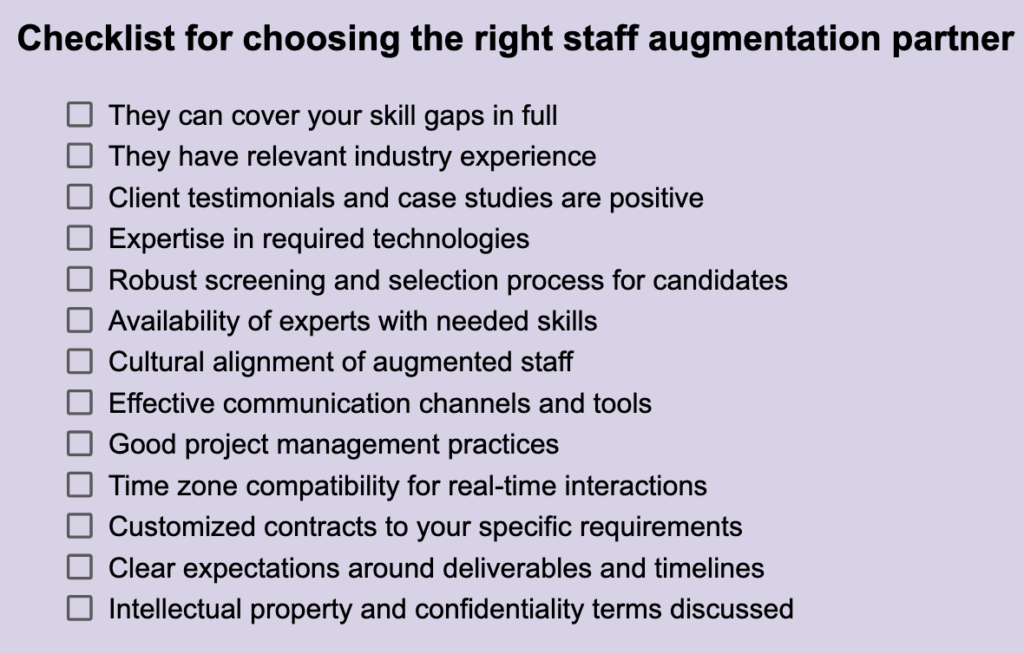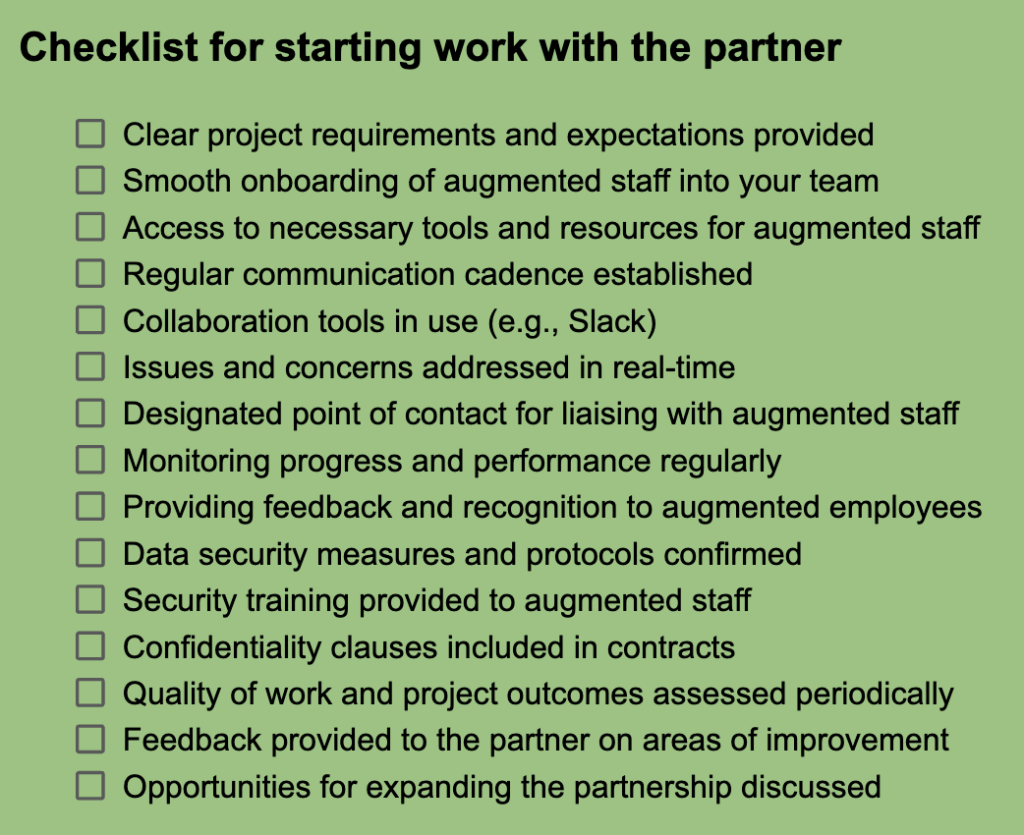Enhancing project delivery in outsourcing companies through effective staff augmentation

Previous article: Enhancing cultural integration in hybrid teams
Outsourcing companies face the constant challenge of balancing specialized talent needs with project demands and cost efficiency. Staff augmentation outsourcing emerges as a powerful solution for enhancing project delivery, enabling them to leverage a global pool of experts, scale teams seamlessly, and achieve exceptional results.
This article dives deep into the benefits of staff augmentation for outsourcing companies, exploring how it unlocks:
- Build expert teams for unique projects by sourcing specialized skills from around the world.
- Respond quickly to changing project requirements by effortlessly scaling teams up or down.
- Maintain competitive pricing and high-quality services by using temporary external talent and improving project delivery.
- Free your internal team to concentrate on strategic initiatives while leveraging augmented staff for specific skills.
- Accelerate project delivery by integrating specialized talent and boosting overall team productivity.
- Gain access to fresh perspectives and diverse experiences, fostering innovation and creative solutions.
Staff augmentation for outsourcing companies 101 — you are here
Fundamentals of staff augmentation for outsourcing
Staff augmentation is an outsourcing strategy where companies hire external professionals or contractors to supplement their in-house team on a temporary basis. However, it differs from other outsourcing models in several ways.
Staff augmentation. This approach involves hiring individual contractors to work alongside the existing team on specific projects. The augmented staff then integrates with the company's team, follows the company's management, and adapts to its processes. This model provides flexibility, allowing companies to quickly scale their team size based on project demands. It's ideal for filling short-term skill gaps or handling workload fluctuations while retaining control over the project.
Project outsourcing (dedicated team). In this model, an entire project or a significant part of it is outsourced to a third-party service provider who is usually accountable for the project delivery, as well. The vendor manages a dedicated team for the project, often remotely. This model suits long-term, complex projects where the company lacks in-house expertise. While the company has less direct control over the team, it can focus on core business activities.

IT outsourcing. Notably, staff augmentation is a broader term that encompasses outsourcing various IT functions or services to a third-party provider. This includes application or web development, infrastructure management, cybersecurity, and other IT-related services. In this case, the outsourcing vendor takes full responsibility for the outsourced IT functions, allowing companies to leverage external expertise with minimal involvement in operations.
Benefits of staff augmentation for outsourcing companies
With staff augmentation, outsourcing firms can respond swiftly to changing client needs, scaling teams without losing focus on maintaining high-quality standards.
Dan Ogden
Staff augmentation offers several key advantages, helping outsourcing companies manage workload peaks, fill skill gaps, and provide resource management flexibility.
Managing workload peaks. Staff augmentation allows companies to quickly scale their teams up or down based on project demands. They can ramp up resources for new projects or scale down once a project is completed. This agility helps match evolving client needs cost-effectively, providing a competitive edge.
Filling skill gaps. For instance, through staff augmentation, outsourcing companies can access a vast global talent pool, enabling them to find specialized skills and expertise not readily available locally. This, in turn, allows them to assemble highly skilled teams tailored to each client's unique project requirements.
Flexibility in resource management. By hiring external talent on a temporary basis, companies avoid the overhead costs of full-time employees, such as benefits, training, and infrastructure expenses. This cost-effective model allows them to remain competitive while delivering high-quality services.
Core competencies focus. Furthermore, staff augmentation frees up internal teams to focus on their core competencies and strategic initiatives. hey can leverage augmented staff for specific skill requirements, ensuring permanent employees remain dedicated to their areas of expertise.
Enhanced productivity. Additionally, the specialized talent brought in through staff augmentation can quickly contribute to projects, reducing ramp-up time and accelerating project delivery timelines, which improves productivity and efficiency and allows companies to capitalize on opportunities swiftly.
Diverse perspectives. Moreover, staff augmentation introduces diverse perspectives, experiences, and expertise to outsourcing teams. This diversity can lead to innovative solutions, fresh ideas, and a broader range of approaches to tackle complex client challenges.
Strategic planning and implementation
Assessing needs and planning
To ensure a successful staff augmentation strategy, it's essential to begin with a thorough needs assessment and planning process.
Identify skill gaps. Assess your team's current capabilities to pinpoint missing skills or expertise. This involves evaluating your team's current capabilities to pinpoint missing skills or expertise, creating a detailed list of the necessary skills, experience levels, and qualifications for the augmented staff.
Analyze workload fluctuations. Determine whether you experience periods of high workload that need temporary staffing or if the requirement is long-term.
Define scope and project delivery timeline. Then, outline integration and management plans for the augmented staff, including communication channels, progress tracking, and knowledge transfer processes.
Set clear objectives. Establish S.M.A.R.T (Specific, Measurable, Achievable, Relevant, Time-bound) objectives for the engagement to align expectations and measure success.
Determine required skills and expertise. Create a detailed list of the necessary skills, experience levels, and qualifications for the augmented staff.
Evaluate budget and costs. Analyze the costs associated with staff augmentation, including hourly rates and overhead expenses, to ensure they align with your budget.
Assess cultural fit. Consider the cultural compatibility between your organization and the potential augmented staff, including shared values and communication styles.
Develop a communication and collaboration plan. Outline integration and management plans for the augmented staff, including communication channels, progress tracking, and knowledge transfer processes. This step is crucial to ensure seamless collaboration between the in-house team and the augmented staff.
Establish performance metrics. Define KPIs to measure the success of the staff augmentation engagement, such as quality, productivity, and adherence to timelines and budgets.
Selecting the right augmentation partner
Choosing the right staff augmentation partner is crucial. Here are key criteria to consider:
Experience and expertise. Next, look for a partner with industry experience relevant to your project. Ensure they have a proven track record and expertise in the required technologies and methodologies.
Quality of talent. Then, assess the partner's talent acquisition and screening processes. Review the qualifications and experience of potential candidates to ensure they can provide top-notch professionals.
Communication and collaboration. Afterwards, evaluate the partner's communication protocols, tools, and processes. Ensure they can integrate seamlessly with your in-house team and bridge any cultural differences.
Flexibility and scalability. Furthermore, a good partner should offer flexibility to adapt to changing project needs. Assess their ability to quickly ramp up or down resources and integrate new team members.
Pricing and value. Evaluate the overall value proposition, including detailed pricing structures and potential long-term cost savings. Ensure the services offered align with your budget and deliver value.

Integration of augmented staff
Effective integration of augmented staff into your existing project teams is essential. Here are some strategies:
Clear communication and expectations. Establish clear communication channels and protocols from the outset. Set clear expectations regarding roles, responsibilities, deadlines, and deliverables.
Onboarding and cultural alignment. Next, develop a comprehensive onboarding process that covers organizational culture, values, processes, and project-specific information. Additionally, assign mentors from the existing team to guide the augmented staff.
Knowledge sharing and collaboration. Firstly, facilitate knowledge-sharing sessions and encourage cross-functional collaboration. Additionally, implement collaborative tools to enable seamless information sharing and project coordination.
Performance management and feedback. Establish clear performance metrics aligned with project objectives. Subsequently, conduct regular performance reviews and provide constructive feedback. Moreover, recognize the contributions of augmented staff to foster motivation.
Security and access management. Implement robust security protocols to protect sensitive information. Provide appropriate access to tools and resources while ensuring compliance with legal and regulatory requirements.

Leveraging technology for efficient project delivery
Project management tools
Project management tools are essential for outsourcing companies as they streamline processes, track progress, allocate resources, and facilitate communication. Furthermore, centralized platforms provide a clear overview of project status and progress.
Gantt chart tools. Visual representations of project timelines and task dependencies are provided by tools like TeamGantt, GanttPro, and Microsoft Project.
Collaboration tools. Slack, Microsoft Teams, and Basecamp enable communication, file sharing, and real-time collaboration among team members.
Project portfolio management (PPM) tools. Planview, Clarizen, and Adobe Workfront allow organizations to manage multiple projects simultaneously, allocate resources, and track portfolios.
Agile project management tools. Tools like Jira, VersionOne, and Pivotal Tracker support Agile methodologies with features like sprint planning and burndown charts.
Benefits of using project management tools
Improved visibility and transparency. Centralized platforms provide a clear overview of project status and progress.
Enhanced collaboration. Additionally, these tools facilitate better communication and teamwork, leading to increased productivity and efficiency. Effective management and allocation of resources based on real-time data are crucial.
Accurate resource allocation. Effective management and allocation of resources based on real-time data.
Streamlined reporting. Insights based on data enable informed decision-making and effective risk management.
Data-driven decision-making
Indeed, knowledge-powered decision-making leverages analytics to optimize staffing decisions and project delivery. To begin with, clearly articulate the decision to be made or the problem to be solved.
Define the problem or question. Clearly articulate the decision to be made or the problem to be solved.
Collect relevant data. Next, gather data from various internal and external sources.
Analyze the data. Then, use statistical and analytical techniques to identify patterns, trends, and correlations. Consequently, this data provides insights into customer behavior, market trends, and business processes.
Interpret the findings. Draw actionable insights from the analysis to inform decisions.
Make the decision. Use data-driven insights along with other factors to make informed choices.
Monitor and iterate. Continuously evaluate the outcomes and refine the decision-making process.
Benefits of data-driven decision-making
Increased accuracy and objectivity. Decisions are based on actual data rather than intuition.
Better understanding of operations. Data provides insights into customer behavior, market trends, and business processes.
Optimization of processes. Identifies opportunities for improvement and enhances resource allocation.
Competitive advantage. Leveraging data-driven insights provides a strategic edge over competitors.
Security and compliance in technology use
Ensuring security and maintaining compliance are critical when integrating new technologies and augmented staff. Here are the key aspects:
Security
Access controls and authentication. Implement robust mechanisms to protect against unauthorized access.
Encryption and data protection. Lastly, safeguard sensitive information through encryption and other data protection measures.
Network security. Furthermore, utilize firewalls and intrusion detection/prevention systems to secure the network infrastructure.
Incident response. Develop and maintain incident response and disaster recovery plans.
Security awareness. Conduct training programs to raise awareness about security best practices.
Compliance
Adherence to regulations. Ensure compliance with laws and standards like GDPR, PCI DSS, HIPAA, and ISO 27001.
Audits and assessments. Regularly evaluate the effectiveness of security controls through compliance audits.
Policy implementation. Develop and enforce internal policies to meet compliance requirements.
Integrating security and compliance
Mutual reinforcement. Compliance mandates specific security controls, and robust security practices help achieve compliance.
Risk management. Both programs work together to manage risks, protect data, and maintain stakeholder trust.
Continuous improvement. Use audit findings to enhance security measures and maintain compliance.
Managing challenges in staff augmentation
Common pitfalls and solutions
Staff augmentation offers significant benefits, but it comes with challenges. Here are typical pitfalls and their solutions:
Lack of cultural fit and integration. Augmented staff may face difficulties integrating with existing teams due to cultural differences or communication barriers.
- Solution. Implement a comprehensive onboarding process, foster an inclusive environment, and assign mentors from the existing team to facilitate integration and knowledge transfer.
Quality control and consistency. Variations in the quality of work can occur, especially if augmented staff are not familiar with company standards.
- Solution. Establish clear performance standards, implement robust quality assurance processes, and ensure thorough documentation of project requirements and best practices.
Security and confidentiality risks. External personnel can introduce security risks and potential breaches of confidentiality.
- Solution. Require non-disclosure agreements, limit access to sensitive information, and implement strict security protocols and monitoring.

Knowledge transfer and training overhead. Significant time and resources may be required to bring augmented staff up to speed.
- Solution. Develop structured training programs, leverage experienced augmented staff or project managers, and implement practices like pair programming to accelerate learning.
Dependency and sustainability. Over-reliance on augmented staff can lead to vulnerability if they become unavailable.
- Solution. Use staff augmentation strategically for specialized skills or temporary needs, while investing in developing internal talent and capabilities.
Quality assurance and control
Maintaining high-quality project delivery despite fluctuating team compositions is crucial. Here are some strategies:
Vendor selection and evaluation. Thoroughly evaluate potential vendors' quality management processes, certifications, and past performance. Conduct audits and check client references to assess their capabilities and quality control practices.
Clear requirements and specifications. Provide detailed documentation outlining quality expectations, standards, and acceptance criteria. Ensure the vendor demonstrates understanding of these requirements during the selection process.
Robust contract management. Include well-defined service level agreements (SLAs) with quality metrics and penalties for non-compliance. Specify quality assurance activities and define issue resolution, change management, and escalation processes in the contract.
Collaborative development approach. Implement Agile development methodologies with frequent iterations and feedback loops. Assign quality analysts to work closely with the vendor's team and conduct regular status meetings to discuss quality issues.
Comprehensive testing strategy. Use a blended approach of automated and manual testing, perform different types of testing (functional, integration, security, performance), and leverage in-house QA teams or third-party testing services for independent validation.
Continuous monitoring and governance. Establish quality metrics and key performance indicators (KPIs) to track vendor performance. Implement quality assurance tools for code analysis, defect tracking, and test management, and conduct periodic audits and quality reviews.
Sustainability and scalability
Ensuring sustainability and scalability in staff augmentation practices is vital for long-term success as the company grows. Here are some considerations:
Sustainability challenges
Over-reliance on external talent. This can hinder the development of internal capabilities and lead to a lack of knowledge transfer.
- Solution. Maintain a balanced talent strategy with a core team of internal experts and strategically use external talent.
Continuity and retention. High turnover rates among augmented staff can disrupt project continuity.
- Solution. Implement robust onboarding and training programs and foster collaboration and knowledge sharing.
Scalability challenges
Resource management. Efficiently scaling teams up or down can be challenging with fluctuating project demands.
- Solution. Adopt agile methodologies that promote flexibility and iterative planning.
Quality assurance. Maintaining consistent quality standards can be difficult with diverse skill sets.
- Solution. Define and monitor KPIs for quality, productivity, and client satisfaction, and invest in talent development to build a versatile internal talent pool.
Conclusion
Effective staff augmentation can transform project delivery for outsourcing companies. Here are the key strategies discussed:
- Thorough needs assessment. Identify skill gaps, analyze workload fluctuations, and define project scope to ensure precise resource planning.
- Strategic partner selection. Choose partners with relevant experience, robust quality control, and effective communication practices.
- Seamless integration. Implement comprehensive onboarding, foster cultural alignment, and promote knowledge sharing for smooth team integration.
- Quality assurance and control. Establish clear performance standards, use comprehensive testing strategies, and continuously monitor quality.
- Sustainability and scalability. Maintain a balanced talent strategy, adopt agile methodologies, and invest in internal talent development for long-term success.
Outsourcing companies, it's time to elevate your project delivery. By adopting these best practices, you can harness the full potential of staff augmentation to meet and exceed client expectations. Embrace these strategies to build resilient, scalable, and high-performing teams that drive success in every project.
Next article: Scaling workforce without losing quality
Egor Kaleynik
IT-oriented marketer with B2B Content Marketing superpower. HackerNoon Contributor of the Year 2021 Winner – MARKETING. Generative AI enthusiast.
Featured in: Hackernoon.com, Customerthink.com, DZone.com, Medium.com/swlh
More info: https://muckrack.com/egor-kaleynik